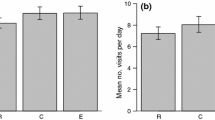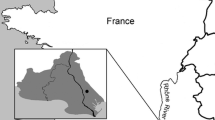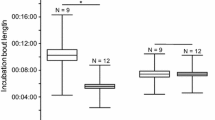Abstract
The males of the European Starling (Sturnus vulgaris) and Spotless Starling (S. unicolor) carry green plants to their nests. However, the consequences of this behaviour for the females are still poorly known. In this study, we evaluated the behavioural responses of female Spotless Starlings to the green plants that they find in their nests. We added green plants to a group of experimental nests (E nests) and quantified the activity of the nesting females in the E nests and in a group of non-manipulated nests (C nests). The females never added green plants to their nests, but they removed the green plants more frequently from the E nests than from the C nests. The number of departures from the nest by females that carried green plants was positively correlated with the number of visits by females that carried nothing. In contrast, the number of departures by females carrying green plants was uncorrelated with the number of visits made by females that carried nest-building materials. These results suggest that the females made a specific additional effort to remove the green plants from the E nests. We propose that this behaviour may be an adaptive response of mated females that serves to counteract the eventual negative effects of green plants on their reproductive success. However, competing hypotheses cannot be rejected, and additional work is needed to better understand the removal of green plants by female Spotless Starlings.
Zusammenfassung
Weibliche Einfarbstare entfernen grüne Pflanzen aus ihren Nestern
Die Männchen des Stars (Sturnus vulgaris) und des Einfarbstars (S. unicolor) tragen grüne Pflanzen in ihre Nester ein. Die Folgen dieses Verhaltens für die Weibchen sind jedoch schlecht verstanden. In dieser Studie haben wir die Verhaltensantworten von Weibchen des Einfarbstars auf die Pflanzen, die sie in ihren Nestern finden, ausgewertet. Wir haben zu einer Gruppe von experimentellen Nestern (E-Nestern) grüne Pflanzen hinzugefügt und die Aktivität der brütenden Weibchen in den E-Nestern sowie in einer Gruppe von unmanipulierten Nestern (C-Nestern) quantifiziert. Die Weibchen haben niemals grüne Pflanzen in ihre Nester eingetragen, aber haben die grünen Pflanzen häufiger aus den E-Nestern als aus den C-Nestern entfernt. Die Anzahl der Abflüge vom Nest durch Weibchen, die grüne Pflanzen trugen, korrelierte positiv mit der Anzahl der Besuche von Weibchen, die nichts trugen. Im Gegensatz dazu war die Anzahl der Abflüge von Weibchen, die grüne Pflanzen trugen, nicht mit der Anzahl der Besuche von Weibchen, die Nistmaterial trugen, korreliert. Diese Ergebnisse deuten darauf hin, dass die Weibchen sich ausdrücklich „bemühten“, die grünen Pflanzen aus den E-Nestern zu entfernen. Wir schlagen vor, dass dieses Verhalten eine adaptive Antwort verpaarter Weibchen sein könnte, die dazu dient, den letztendlich negativen Effekten grüner Pflanzen auf ihren Fortpflanzungserfolg entgegenzuwirken. Andere Hypothesen können jedoch nicht abgelehnt werden, und zusätzliche Arbeit ist notwendig, um das Entfernen von grünen Pflanzen durch weibliche Einfarbstare besser zu verstehen.

Similar content being viewed by others
References
Arenas M (2000) Inversión parental, estatus de emparejamiento e interferencia social en el estornino Negro, Sturnus unicolor. Importancia del conflicto sexual en el desarrollo de estrategias de reproducción. MS dissertation, Universidad Complutense, Madrid
Brouwer L, Komdeur J (2004) Green nesting material has a function in mate attraction in the European starling. Anim Behav 67:539–548
Calvo JM, Pascual JA, Deceuninck B, Peris SJ (2000) Intraspecific nest parasitism in the spotless starling Sturnus unicolor. Bird Study 47:285–294
Cardoso GC, Mota PG, Depraz V (2007) Female and male serins (Serinus serinus) respond differently to derived song traits. Behav Ecol Sociobiol 61:1425–1436
Clark L (1991) Countering parasites and pathogens. Parasitol Today 6:358–360
Clark L, Mason JR (1985) Use of nest material as insecticidal and anti-pathogenic agents by the European starling. Oecologia 67:169–176
Clark L, Mason JR (1988) Effect of biologically active plants used as nest materials and the derived benefit to starling nestlings. Oecologia 77:174–180
De Ridder E, Pinxten R, Eens M (2000) Experimental evidence of a testosterone-induced shift from paternal to mating behaviour in a facultatively polygynous songbird. Behav Ecol Sociobiol 49:24–30
Fauth PT, Krementz DG, Hines JE (1991) Ectoparasitism and the role of green nesting material in the European starling. Oecologia 88:22–29
Gwinner H (1997) The function of green plants in nests of European starlings (Sturnus vulgaris). Behaviour 134:337–351
Gwinner H, Berger S (2005) European starlings: nestling condition, parasites and green nest material during the breeding season. J Ornithol 146:365–371
Gwinner H, Oltrogge M, Trost L, Nienaber U (2000) Green plants in starling nests: effects on nestlings. Anim Behav 59:3001–3309
Kral M, Saetre GP, Bicik V (1996) Intrasexual aggression of female collared flycatchers (Ficedula albicollis): competition for male parental care? Folia Zool 45:153–159
Lambrechts MM, Dos Santos A (2000) Aromatic herbs in Corsican blue tit nests: the ‘Potpourri’ hypothesis. Acta Oecol 21:175–178
Lombardo MP, Power HW, Stouffer PC, Romagnano LC, Hoffenberg AS (1989) Egg removal and intraspecific brood parasitism in the European starling (Sturnus vulgaris). Behav Ecol Sociobiol 24:217–223
López-Rull I, Gil D (2009) Elevated testosterone levels affect female breeding success and yolk androgen deposition in a passerine bird. Behav Process 82:312–318
Mennerat A (2008) Blue tits (Cyanistes caeruleus) respond to an experimental change in the aromatic plant odour composition of their nest. Behav Process 79:189–191
Mennerat A, Perret P, Bourgault P, Blondel J, Gimenez O, Thomas DW, Heeb P, Lambrechts MM (2009a) Aromatic plants in nests of blue tits: positive effects on nestlings. Anim Behav 77:569–574
Mennerat A, Perret P, Lambrechts MM (2009b) Local individual preferences for nest materials in a passerine bird. Plos One 4:e5104
Parejo D, Pérez-Contreras T, Navarro C, Soler JJ, Avilés JM (2008) Spotless starlings rely on public information while visiting conspecific nests: an experiment. Anim Behav 75:483–488
Pinxten R, Eens M, Verheyen RF (1991) Conspecific nest parasitism in the European starling. Ardea 79:15–30
Polo V, López-Rull I, Gil D, Veiga JP (2010) Experimental addition of green plants increases testosterone levels in female spotless starlings. Ethology 116:129–137
Rosvall KA (2008) Sexual selection on aggressiveness in females: evidence from an experiment with tree swallows. Anim Behav 75:1603–1610
Sandell MI, Diemer M (1999) Intraspecific brood parasitism: a strategy for floating females in the European starling. Anim Behav 57:197–202
Shutler D, Campbell AA (2007) Experimental addition of greenery reduces flea loads in nests of a non-greenery using species, the tree swallow Tachycineta bicolor. J Avian Biol 38:7–12
Veiga JP (1992) Why are house sparrows predominantly monogamous. A test of hypotheses. Anim Behav 43:361–370
Veiga JP, Polo V (2008) Fitness consequences of increased testosterone levels in female spotless starlings. Am Nat 139:669–675
Veiga JP, Moreno J, Cordero PJ, Mínguez E (2001) Territory size and polygyny in the spotless starling: resource holding potential or social inertia. Can J Zool 79:1951–1956
Veiga JP, Polo V, Viñuela J (2006) Nest green plants as a male status signal and courtship display in the spotless starling. Ethology 112:196–204
Vicario DS, Naqvi NH, Raksin JN (2001) Sex differences in discrimination of vocal communications signals in a songbird. Anim Behav 61:805–817
Wimberber PH (1984) The use of green plant material in bird nests to avoid ectoparasites. Auk 101:615–618
Yom-Tov Y, Dunnet GM, Anderson A (1974) Intraspecific nest parasitism in the starling Sturnus vulgaris. Ibis 116:87–90
Acknowledgments
We are indebted to two anonymous reviewers for their constructive criticisms. This research has been funded by projects CGL2005-05611-C02-01/BOS of the Ministry of Education and Science and CGL2008-02843/BOS of the Ministry of Science and Innovation. The experiments comply with the current laws of Spain.
Author information
Authors and Affiliations
Corresponding author
Additional information
Communicated by T. Friedl.
Rights and permissions
About this article
Cite this article
Veiga, J.P., Polo, V. Female Spotless Starlings (Sturnus unicolor) remove green plants from their nests. J Ornithol 153, 291–296 (2012). https://doi.org/10.1007/s10336-011-0742-x
Received:
Revised:
Accepted:
Published:
Issue Date:
DOI: https://doi.org/10.1007/s10336-011-0742-x




